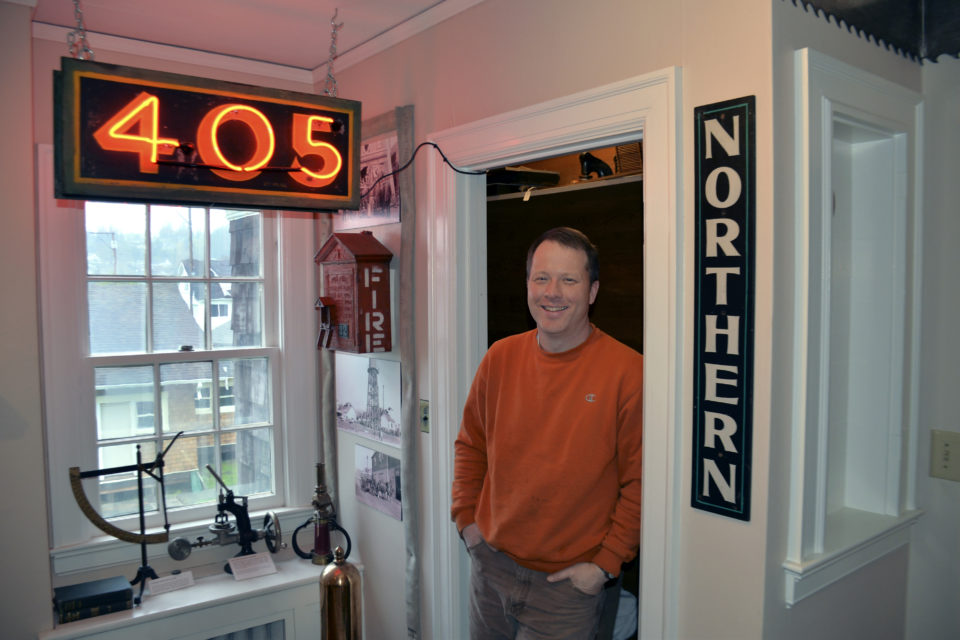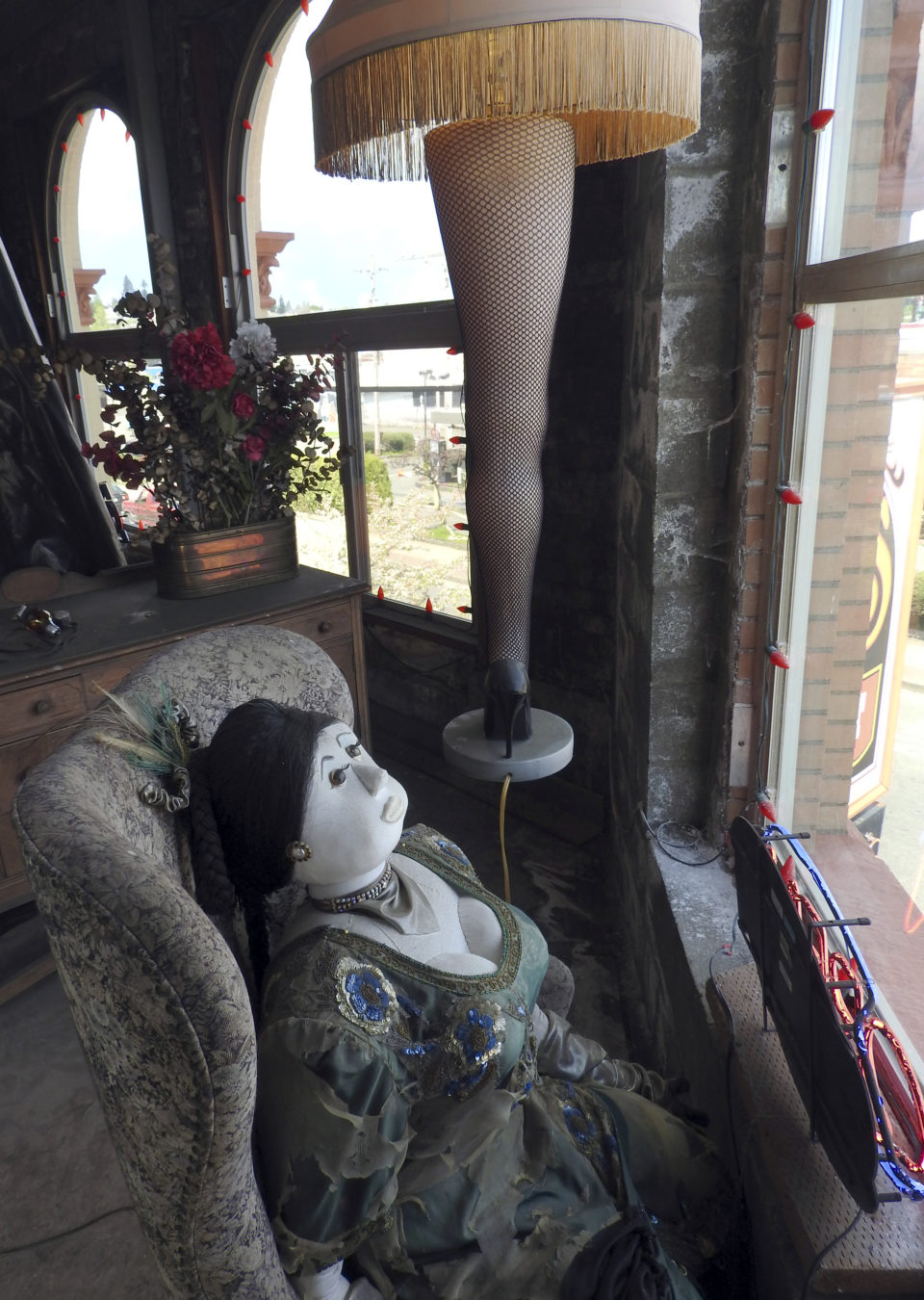
Photo by Dan Hammock
John Larson, director of the Polson Museum in Hoquiam, stands between the original neon sign from the 405 brothel and a simple wooden sign for the Northern, another of Aberdeen’s “sporting houses” from the 1950s. The 405 was a small, white two-story building that usually had two working girls at a time. The sign was donated by a local resident who salvaged it as the building was being demolished.
It was a rite of passage for a number of young men in the 1950s: Save up your money and head to Aberdeen for a little adult entertainment at one of a number of brothels that did a thriving business into the early ’60s.
A cluster of them stood at the west end of the Heron Street Bridge. One of the “higher class” houses was the Curtis Hotel, at 303½ E. Heron. A block away was the Ritz Hotel, and a block and a half south and east was the 405, at 405 E. State St. Another, called Elnora’s Rooms, reportedly operated above the old Hayes and Hayes Bank at Heron and G streets, where Billy’s Restaurant is now. There was even one called Fannie’s that featured only black women – an exotic adventure for men in the region at the time.
There were others, of course, but these were the places that advertised with not-so-subtle matchbooks, business cards and fliers that did little to hide the fact they were indeed “sporting houses.” They were never technically legal here, yet they served everyone from sailors and lumbermen to curious teens.
Little remains of this portion of Aberdeen history. A few advertisements and some original signs from the 405 and another, the Northern, found a place at the Polson Museum in Hoquiam; but most of the buildings are gone, leaving the few who talk about them with their own memories and some darn good stories.
The price was the same, regardless of the venue, said John Larson, director of the Polson Museum in Hoquiam, which sports a small display of some of the memorabilia from that era. Whether it was the Curtis or the Iowa Rooms at 409½ E. Heron – considered to be the lowest class of them all – you’d have to pay only $5 to $5.50 for basic services. There was also a package called the “Around the World” – but with a $20 price tag, the average client could only imagine what that involved.
A trio of men from Montesano shared their remembrances of their 1950s experiences at Aberdeen’s brothels with Larson in 2005. Their story will be shared here, but for obvious reasons, not their identities.
“They went as frequently as their meager budgets would permit during that two-year period” between 1956 and 1958, said Larson. “They truly were the last participants in Aberdeen’s long history as one of the West Coast’s busiest sporting house cities.”
Friends would pool whatever cash they could come up with – a dollar here, two dollars there – and then draw lots to see who would be “the lucky one.”

Billy’s Restaurant, at Heron and G streets in Aberdeen, once housed a bank – and it reportedly had a sporting house called Elnora’s Rooms above it. The restaurant uses the second floor for storage, but they celebrate the building’s bawdy history with this window dressing.
Larson relayed the story of one group that included a skilled pinball wizard, back when there were machines that could pay out much like a slot machine. The friends would give their cash to their pinball pal in hopes he could turn it into enough money for a visit to the brothel.
The service was similar in each establishment. Clients would enter and be quickly escorted by the madam, usually a matronly older woman, into a waiting room where the women would line up, usually on chairs or couches and more often than not wearing the type of lingerie not usually seen – or seen through – on the Harbor at the time.
The client would make his selection and be whisked into a small room – sometimes decorated with a picture or two on the wall, but never with a mirror. The room would contain a small porcelain-enameled steel washbasin with soap and water, and of course a bed. The client would be washed, serviced and washed again, and the transaction was complete.
According to former clients, the women in the brothels appeared to be in their 30s or older – though they admitted they were making those estimations through the memories of a teenage boy.
The brothels required some proof of age, though most were casual at best about enforcement. Larson said many young men would photocopy a driver’s license, put tape over the name, then write in their own. Despite the fact licenses didn’t have photos at the time, the frauds were easy to spot – but they rarely kept a client from getting through the door.

An old matchbook advertises the 405, which was considered one of Aberdeen’s classier sporting houses in the late 1950s.
Larson relayed the story of a young woman who wanted to join the KBA Club, a sorority of sorts at Weatherwax High School in Aberdeen. Part of the initiation was to have recruits go to 405 E. State St. and ask the proprietor for a job. Of course, those recruits had no idea what the 405 was.
“The woman who answered the door was very rude and slammed the door in her face,” said Larson. “(The student) went home and told her dad that she had gone to the 405, and he made her swear that she wouldn’t let her mother know, as he explained to her that the business was a whorehouse.”
One of the aforementioned Montesano trio was once on his way up the stairs at the Ritz and passed an adult neighbor who was coming down. An awkward glance gave way to the older man saying, “You’re a good kid,” before he went back upstairs and paid for the teen’s evening.
On another occasion, the three took a friend to Fannie’s. Fannie herself was talking to the boys when she abruptly grabbed a broom handle and pounded on the ceiling, yelling “Time’s up!” to a client upstairs.
“The guys noted that they never had that happen to them,” Larson added with a grin.

The artwork on a business card for the Iowa Hotel leaves little question as to the services offered there by “Jackie Adams, Mgr.”
The relationship between the Aberdeen brothels and most of the other neighborhood businesses was good by most accounts, said Larson.
The fancier clothing the women wore made for good business at the higher-end women’s clothing stores, most of them located within a few blocks of the brothels: Pearson’s at 122 E. Heron, Browers at 200 E. Heron and Wolf’s at 209 S. Broadway.
“They catered to the wealthy women up Broadway,” said Larson, speaking of the road leading up the hill to the high-end neighborhoods north of downtown, “and to these women as well.”
The brothels’ lobbies were always opulently furnished, which also made them attractive to furniture dealers in the area.
And they knew how to treat other service industries, too.
“The newspaper delivery people said they always tipped very well, and the women were always very friendly,” said Larson. Same for the local restaurants, who would deliver food to the girls when called upon.

The front of the business card for the Ritz Hotel advertises “steam heat” and “hot and cold water”.
The end of the road for Aberdeen’s brothels came in the late ’50s. Prostitution had always been illegal, but there was an air of tolerance for decades between the law in Aberdeen and the working girls. The details of this relationship are obviously tough to document, but for the most part the two left each other alone.
Then an Aberdeen Police captain named Nick Yantsin took it upon himself to drive out the sporting houses, starting with a raid on the Harbor Rooms in January 1959. The raids spread and soon took on the Curtis and its strong-willed madam, Nellie Curtis.
The battle between Yantsin and Curtis is documented by Ryan Teague Beckwith in the book “On the Harbor,” a collection of stories of the region’s colorful past gleaned from the pages of The Daily World newspaper in Aberdeen.
The raids were not popular among the local residents – and, since Yantsin was acting without the blessing of the city or anyone else, he lost his job. But the impact of his raids was lasting: The era had ended, with most of the brothels closing up shop as a result. The Curtis was the last to go, around 1961, when its proprietor packed up and left town.

Proprietor Mrs. Anna Lackey spells out the real business plan on the back.